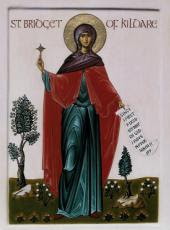 ABBESS, AND PATRONESS OF IRELAND
ABBESS, AND PATRONESS OF IRELAND
She was born at Fochard, in Ulster, soon after Ireland had been blessed with the light of faith. She received the religious veil in her youth. from the hands of St. Mel, nephew and disciple of St. Patrick. She built herself a cell under a large oak, thence called Kill-dara, or cell of the oak; living, as her name implies, the bright shining light of that country by her virtues. Being joined soon after by several of her own sex, they formed themselves into a religious community, which branched out into several other nunneries throughout Ireland; all which acknowledged her for their mother and foundress, as in effect she was of all in that kingdom. But a full account of her virtues has not been transmitted down to us, together with the veneration of her name. Her five modern lives mention little else but wonderful miracles. She flourished in the beginning of the sixth century, and is named in the Martyrology of Bede, and in all others since that age. Several churches in England and Scotland are dedicated to God under her name, as, among others, that of St. Bride in Fleet- street; several also in Germany, and some in France. Her name occurs in most copies of the Martyrology which bears the name of St. Jerome, especially in those of Esternach and Corbie, which are most ancient. She is commemorated in the divine office in most churches of Germany, and in that of Paris, till the year 1607, and in many others in France. One of the Hebrides, or western islands which belong to Scotland, near that of Ila, was called, from a famous monastery built there in her honor, Brigidiani. A church of St. Brigit, in the province of Athol, was reputed famous for miracles, and a portion of her relics was kept with great veneration in a monastery of regular canons at Aburnethi, once capital of the kingdom of the Picts, and a bishopric, as Major mentions. Her body was found with those of SS. Patrick and Columba, in a triple vault in Down-Patrick, in 1185, as Giraldus Cambrensis informs us: they were all three translated to the cathedral of the same city; but their monument was destroyed in the reign of king Henry VIII. the head of St. Bride is now kept in the church of the Jesuits at Lisbon.
